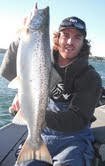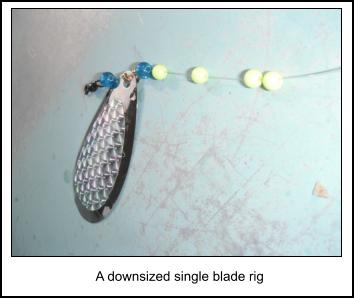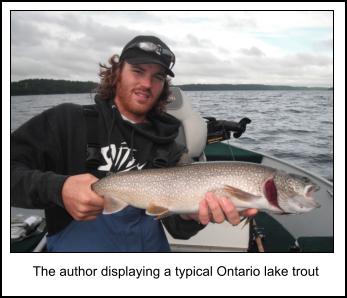|
 Lake
Trout Tips and Tricks! Lake
Trout Tips and Tricks!
 By:
Tyler Dunn
Tyler Dunn Guiding By:
Tyler Dunn
Tyler Dunn Guiding
Ontario’s pristine lakes offer world class
fishing for a variety of fresh water species.
The Ministry of Natural Resources has a soft
spot for one species in particular, lake trout.
Ontario lakes are home to 25% of the world’s
lake trout populations. This is not the only
amazing fact about lake trout from Ontario
waters. Lake trout are definitely a true rarity.
In fact they represent only 1% of all Ontario’s
lakes. Since lake trout are a prized catch and
my surrounding area (Sault Ste. Marie) has the
highest concentration of lakes with populations
of lake trout, I get the opportunity to fish
these very plentiful fisheries.
 Trolling Trolling
Trolling is my most consistent method for
catching lake trout. During the spring when
water temps are still cool, lakers will be
roaming the shallows looking for easy meals.
During this time of year on some lakes, flat
lining can be the easiest way to fool a lake
trout or two. For the most part, I am using
fairly heavy equipment for lake trout. The
reason for this is because of the lures and
baits used. Gang trolls are a staple for many
anglers when targeting lake trout. Although
extremely effective they must be used with a
heavy rod with heavy line. The resistance on
these lures is extremely heavy which is caused
by the multiple, large blades spinning. A quick
fix to downsize your gang trolls for a
presentation that can be used out of a small
boat or canoe with light tackle is a simple
task. Remove one blade and clevis off your gang
troll and tie it onto a piece of 20#
monofilament with a barrel swivel above and a
snelled hook followed by a treble on the
business end. Often times, I will add different
colours of prism tape on my blades either at
home before I head out or even in the boat
during the day.
Even though downriggers are not always needed, I
always have them on the boat. This is because
even during ice out conditions, I have found and
caught good numbers of fish in the 40-80 foot
depth. Often these fish are tight to bottom and
a downrigger will give you the opportunity to
run your bait directly on or slightly above
bottom. Another great asset for using
downriggers is the added ability for tight, boat
manoeuvres. Power turns, neutral drops and speed
bursts are always incorporated in my trolling
pattern for lakers, let alone any other species.
Often these speed changes will trigger following
fish into striking.
 Jigging Jigging
A day on the water chasing lake trout with a jig
rod almost always entails deep water. Because of
the deep water, braid or fused lines that offer
no stretch is an absolute must. The advantages
of these super lines are that they put you in
direct contact with the fish. A three foot
fluorocarbon leader attached to your braid with
a small barrel swivel will help with stealth and
line twist.
Jigging lures come in many different shapes,
sizes and profiles. Typically, I will begin
working a heavy vertical lure such as a swedish
pimple or buzz bomb. With these heavy baits and
braided line, I can keep direct contact with
bottom, pounding the Swedish pimple looking for
an aggressive strike. Dressing the treble hook
with small plastics like a micro tube jig offers
lake trout a bulkier presentation which quiet
often is exactly what they are looking for.
Other times when the fish are there but not
responding to this presentation a fluttering
jigging spoon such as a Williams can’t be beat.
I like to work these methodically throughout the
entire water column starting from the bottom and
working up, ten feet at a time. Surprisingly
enough, tackle more commonly used on the ice
such as a jigging rapala can be just as
effective from a boat. Either worked bare or
tipped with a minnow head on the treble a
jigging rapala often triggers even the most
docile fish.
Take advantage of amazing lake trout fisheries
Ontario has to offer. Contact your local MNR
office and obtain a stock sheet for a complete
list of the stocked lakes and give Ontario lake
trout a try!
|